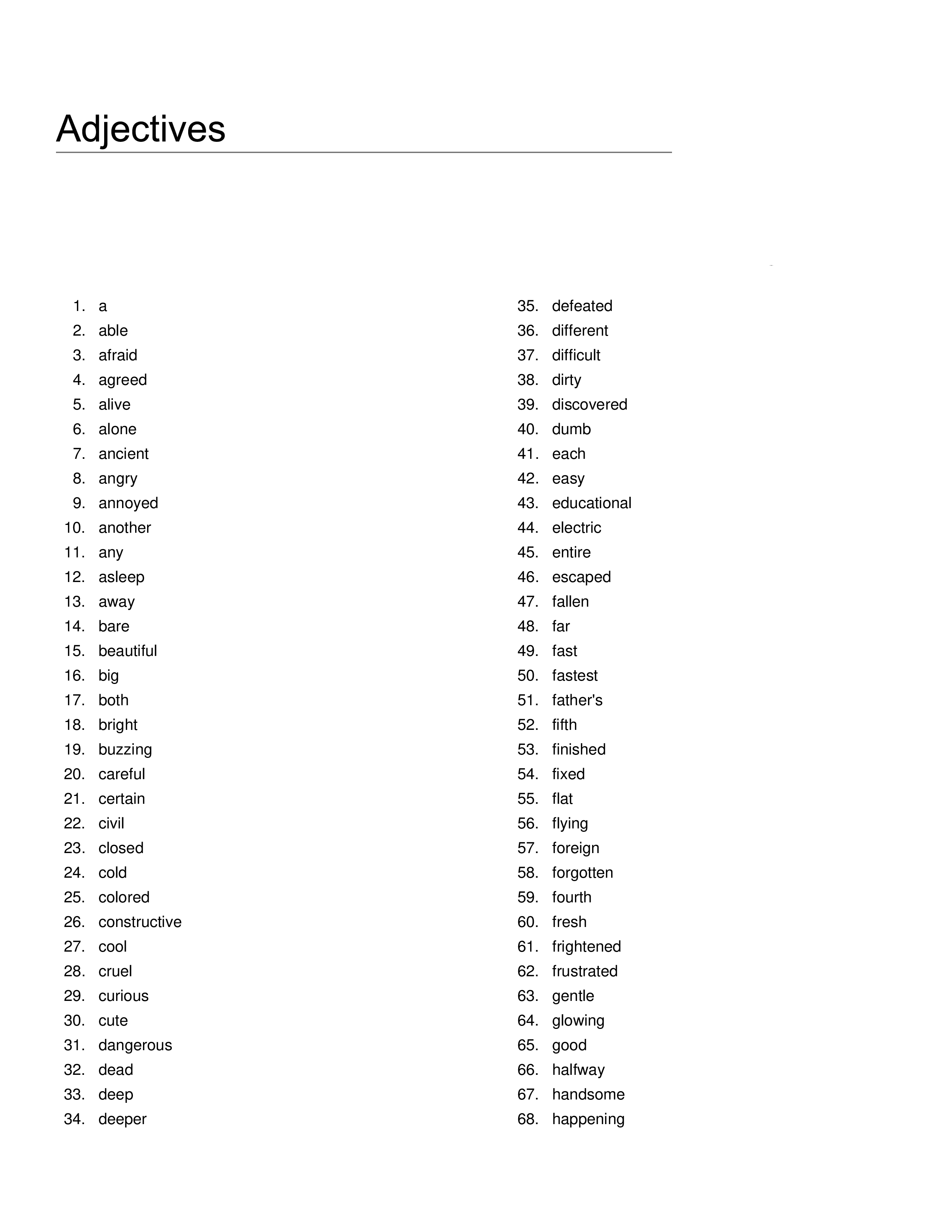List of Adjectives
Sponsored Link免费模板 保存,填空,打印,三步搞定!

Download List of Adjectives
Adobe PDF (.pdf)- 本文档已通过专业认证
- 100%可定制
- 这是一个数字下载 (69.58 kB)
- 语: English
Sponsored Link
How to use Adjectives in English Language? Download this Adjectives List template now!
Creating a comprehensive list of adjectives in the English language is a monumental task, as there are thousands of adjectives to choose from. Adjectives are words that describe or modify nouns and pronouns, and they come in various categories such as descriptive adjectives, demonstrative adjectives, possessive adjectives, and more.
Remember that learning adjectives is an ongoing process. The more you read, write, and engage with the English language, the more adept you will become at using adjectives effectively. Additionally, studying them in context is often more beneficial than simply memorizing lists.
What are adjectives list?
To study adjectives effectively, you can follow these steps:
- Start with Common Adjectives: Begin by studying common adjectives that are used frequently in everyday language. These include adjectives like "happy," "sad," "beautiful," "angry," "small," "big," "red," "green," and so on.
- Use Online Resources: There are numerous online resources, websites, and apps that provide lists of adjectives categorized by different attributes, such as size, shape, color, personality, etc. These resources can be helpful for expanding your vocabulary.
- Read Widely: Reading books, newspapers, magazines, and online articles exposes you to a wide range of adjectives used in context. Pay attention to how adjectives are used to describe people, places, objects, and emotions.
- Thematic Lists: Create thematic lists of adjectives. For example, you can make lists of adjectives related to emotions (e.g., happy, sad, excited), physical appearance (e.g., tall, short, slim), weather (e.g., sunny, rainy, windy), and so on. This helps you remember adjectives in context.
- Flashcards: Create flashcards with adjectives on one side and their definitions or sample sentences on the other side. Review these flashcards regularly to reinforce your knowledge.
- Use Adjective Worksheets: You can find adjective worksheets and exercises online or in grammar books. These worksheets often include fill-in-the-blank sentences where you need to choose the correct adjective.
- Practice Writing: Write short paragraphs or essays that incorporate a variety of adjectives. This hands-on practice can help reinforce your understanding of how adjectives function in sentences.
- Language Learning Apps: Many language learning apps, such as Duolingo and Memrise, include adjective lessons and exercises that make learning adjectives engaging and interactive.
- Play Word Games: Play word games like Scrabble, Boggle, or crossword puzzles, which often involve using adjectives to form words and complete sentences.
- Seek Feedback: Share your writing or sentences with a teacher, tutor, or language partner who can provide feedback on your use of adjectives.
We support you and you with this Adjectives List template, which will save your time and effort and help you to reach the next level of success in your work, education, and business! This blank Adjectives List has ways to grab your readers attention. This list of adjectives template is intuitive, ready-to-use and structured in a smart way. Try it now and let this template inspire you. We certainly hope that this Adjectives List will fit your needs.
Download this Adjectives List template now!
DISCLAIMER
Nothing on this site shall be considered legal advice and no attorney-client relationship is established.
发表评论。 如果您有任何问题或意见,请随时在下面发布
相关文件
Sponsored Link

